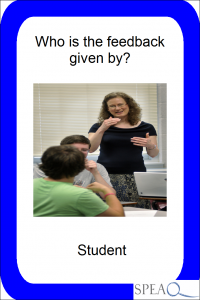Getting the most out of feedback: Pack of cards
Description of contents
The pack contains 72 cards sorted into seven colour groups.
Grey: What is the feedback on?
Blue: Who is the feedback given by?
Yellow: To whom is the feedback given?
Green: Context in which the feedback takes place.
Red: How is feedback delivered?
Purple: Geographical location of feedback.
Orange: What form does the feedback take?
The question is written at the top of each card. A location, person, organisation etc., is written at the bottom of the card. Some of these have been left blank for you to make your own cards.
Printing off the cards (Important)
The cards are available as a .pdf file. You can print the cards either single sided or with a card back made up of partner logos.
- If you wish to use the cards without the backs, print pages 1 to 9. Make sure your printer is set to one-sided printed.
- If you wish to print the backs as well, print from page 9 to the end. Don’t forget to set your printer to duplex (doubled-sided).
- Foxit Reader (recommended). For the purpose of printing it is preferable to use the free Foxit Reader rather than Adobe Acrobat Reader. Select <Print . <Print pages 9-25. < 2-sided. Select ‘None’ for scaling type and make sure the “auto-rotate” and “auto-center” options are not selected.
- Acrobat Reader: Adobe Acrobat reader does not have the correct functionality to line up the fronts and backs of the cards. The full version should have the necessary features to make this possible.
- You may wish to laminate your cards to increase their life.
Activities: These are some of the activities you might like to try in a professional development setting.
Activity 1 : Scenario builder
Purpose: To demonstrate some of the thousands of possible scenarios in which feedback can occur.
Instructions: The workshop facilitator (deal) presents each participant of pair of participants with one card of each colour. The participant (or pair) puts together a short one paragraph description of a real or imagined scenario in which the combination of cards occur.
Reflection: There are thousands of different combinations of cards. Participants will be able to see that there are thousands of possible situations and scenarios in which feedback can occur.
Activity 2: Pick a card (icebreaker)
Purpose: To encourage reflection on how a participant might use of receive feedback in their work.
Instructions: The facilitator shuffles together all the cards and hands one to each participant. Each participant then shows his/ her card to the other participants and explains how the card might apply in their job/ study role.
Reflection: Participants are each able to identify one way in which feedback occurs in the context of their job role. If they are unable to think of a situation they might think about how it may apply to their role in the future.
Modification of the card deck
The deck of cards was built using the card-making software Nandeck, which can be downloaded free of charge from http://www.nand.it/nandeck/. The programme source file is available here (.txt). Unfortunately neither the author, nor the University of Southampton are able to provide technical support for using Nandeck.
Playing cards (.pdf)
Source file for use with NanDeck (.txt)
Copyright and permissions.

This work is licensed under a Creative Commons Attribution-ShareAlike 3.0 Unported License.
This work has been developed by John Canning, University of Southampton, UK as part of the ‘Getting the most out of Feedback project’ (GMOOF). GMOOF is a sub project of the Sharing Practice in Enhancing and Assuring Quality (SPEAQ) project. This work is licensed under the Creative Commons Attribution-ShareAlike 3.0 Unported License. To view a copy of this license, visit the website or send a letter to Creative Commons, 444 Castro Street, Suite 900, Mountain View, California, 94041, USA.
All photographs have been made available under a Creative Commons licence. CC. SA, NC: Center for Teaching Vanderbilt University, University of Central Arkansas, Filipe Ferreira, Pimlico Badger, Mikel Manitius, Vancouver Film School.